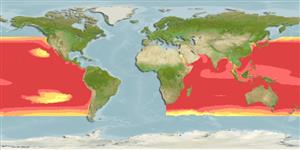分类 / Names
俗名 | 同种异名 | Catalog of Fishes(属, 种) | ITIS | CoL | WoRMS | Cloffa
Environment: milieu / climate zone / depth range / distribution range
生态学
海洋; 海洋洄游的 (Ref. 51243); 深度上下限 0 - 200 m (Ref. 43). 20°C - 25°C (Ref. 54918); 46°N - 49°S, 19°E - 69°W (Ref. 54918)
Indo-Pacific: tropical, subtropical and temperate waters. Highly migratory species.
The distribution in the Pacific Ocean is unique among billfishes and tunas in that it forms a horseshoe-shaped pattern from the northwest Pacific through the eastern Pacific to the southwest Pacific (Ref. 30443). In the Indian Ocean, fish are more densely distributed in equatorial regions with higher concentrations off eastern Africa, in the western Arabian Sea, the Bay of Bengal and off northwestern Australia (Ref. 30444).
Length at first maturity / 大小 / 重量 / 年龄
Maturity: Lm 210.0, range 190 - ? cm
Max length : 420 cm TL 雄鱼/尚未辨别雌雄; (Ref. 30874); common length : 290 cm TL 雄鱼/尚未辨别雌雄; (Ref. 9308); 最大体重: 440.0 kg (Ref. 30874)
背棘 (总数): 0; 背的软条 (总数): 42-48; 臀棘 0; 臀鳍软条: 18 - 24. Body elongated and compressed; upper jaw produced into a robust and medium sized beak; two dorsal fins, the height of the first greater than the greatest depth, short anteriorly, taller in the middle, then becoming shorter posteriorly; pectoral fins falcate and flexible, with 18 to 22 rays; body densely covered by small, embedded scales with 1 or 2 bluntish points; back dark blue; belly silvery; membrane of first dorsal fin blue black without dark spots; flanks with about 20 bluish stripes (Ref. 55763). Blue-black above and silvery white below, with about 15 rows of cobalt-colored stripes; 1st dorsal fin dark blue; other fins dark brown, sometimes with a tinge of dark blue; anal fin bases with a tinge of silvery white.
Epipelagic and oceanic species, usually found above the thermocline. Generally inhabit cooler water than either black (Makaira indica) or blue marlin (M. mazara) (Ref. 43). Most dominant and widely distributed of all billfishes. Their abundance increases with distance from the continental shelf (Ref. 6390). Usually seen close to shore only where deep drop-offs occur (Ref. 6390). Mostly solitary, but form small schools by size during the spawning season (Ref. 9987). They are usually dispersed at considerably wide distances. Feed on fishes, crustaceans and squids. Also caught with the harpoon. The flesh is the best among billfishes for sashimi and sushi. Marketed mostly frozen, sometimes fresh (Ref. 43); also smoked and frozen (Ref. 9987). Also Ref. 9137, 9574.
Life cycle and mating behavior
成熟度 | 繁殖 | 产卵场 | 卵 | 孕卵数 | 仔鱼
Females are indeterminate batch spawners with asynchronous oocyte development (Ref. 92477). Larvae are most abundant in the respective local early summers. The seasonal occurrence of mature females coincides with that of the larvae. The lower temperature limit in the distribution of larvae is approximately 24°C, both in the Indian and Pacific Oceans.
Spawning sites are between 10°S and 30°S in Southwest Pacific and 10°S and 20°S in northeastern Indian Ocean (Ref. 6390).
Nakamura, I., 1985. FAO species catalogue. Vol. 5. Billfishes of the world. An annotated and illustrated catalogue of marlins, sailfishes, spearfishes and swordfishes known to date. FAO Fish. Synop. 125(5):65p. Rome: FAO. (Ref. 43)
人类利用
渔业: 商业性; 游钓鱼种: 是的
更多信息
参考文献养殖养殖信息品种遗传学Electrophoreses遗传率疾病加工NutrientsMass conversion
工具
特别资料
下载 XML
网络资源
Estimates based on models
Preferred temperature (Ref.
123201): 14.6 - 28.3, mean 25.9 °C (based on 1534 cells).
Phylogenetic diversity index (Ref.
82804): PD
50 = 0.7505 [Uniqueness, from 0.5 = low to 2.0 = high].
Bayesian length-weight: a=0.00550 (0.00297 - 0.01015), b=3.15 (2.98 - 3.32), in cm total length, based on LWR estimates for this species & (Sub)family-body (Ref.
93245).
营养阶层 (Ref.
69278): 4.5 ±0.73 se; based on food items.
Generation time: 2.5 (1.5 - 5.0) years. Estimated as median ln(3)/K based on 13
growth studies.
回复力 (Ref.
120179): 中等的, 族群倍增时间最少 1.4 - 4.4年 (K=0.2-0.6; tm=2-3; Fec=90-281 million (annual reproductive output)).
Prior r = 0.22, 95% CL = 0.12 - 0.40, Based on 1 stock assessment.
Fishing Vulnerability (Ref.
59153): Moderate vulnerability (44 of 100).
Climate Vulnerability (Ref.
125649): Moderate to high vulnerability (48 of 100).
Nutrients (Ref.
124155): Calcium = 29.3 [12.2, 54.6] mg/100g; Iron = 0.97 [0.53, 1.79] mg/100g; Protein = 19.9 [18.6, 21.0] %; Omega3 = 0.217 [0.110, 0.427] g/100g; Selenium = 50.6 [25.2, 110.9] μg/100g; VitaminA = 3.89 [1.10, 13.77] μg/100g; Zinc = 0.31 [0.20, 0.48] mg/100g (wet weight);
